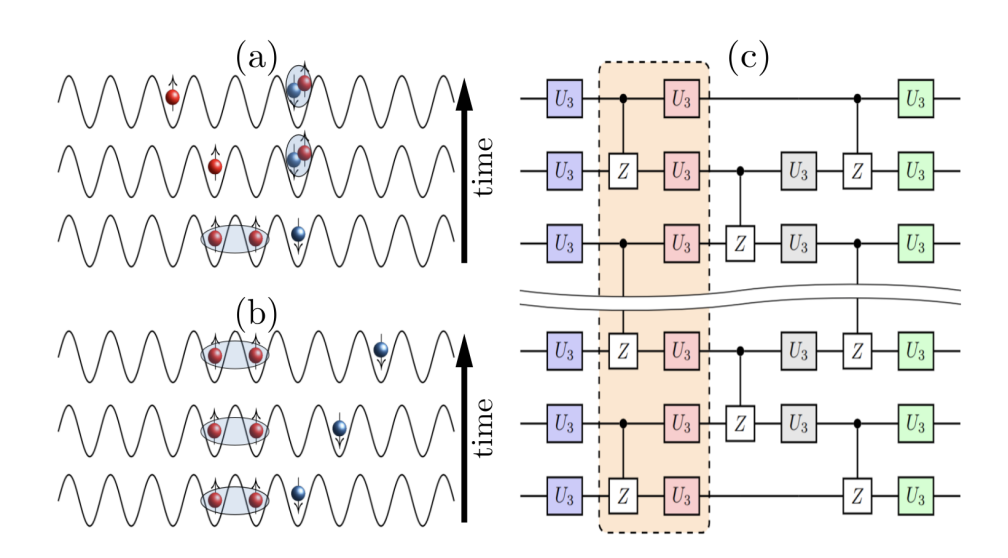Doublon formation, a complex process involving the creation of onsite repulsively bound pairs of particles on a lattice, is a significant phenomenon in quantum computing. This process, part of the continuous time quantum walk, is influenced by factors such as the strength of the down particle compared to the up particle. Quantum computers are used to simulate this process, with the Fermi-Hubbard model playing a crucial role. The research, conducted by Biswajit Paul and Tapan Mishra, provides valuable insights into the dynamics of interacting many-body systems and the role of quantum computers in simulating these dynamics.
What is the Significance of Doublon Formation in Quantum Computing?
The formation of doublons, or onsite repulsively bound pairs of particles on a lattice, is a complex phenomenon that has been observed in quantum computing experiments. This process is part of the continuous time quantum walk in the framework of the one-dimensional extended Fermi-Hubbard model. The formation of a stable onsite doublon in the quantum walk is influenced by several factors, including the strength of the down particle compared to the up particle, and the stability of the doublon is more prominent than the doublon dissociation in the dynamics, irrespective of the hopping asymmetry between the two components.
The study of doublon formation and its stability in many-body systems remains challenging both theoretically and experimentally. However, the quench dynamics of few interacting particles or the continuous time quantum walk (QW) offers a suitable platform to realize such phenomena in the simplest possible way. The formation of a stable doublon in the QW due to strong onsite interaction is well understood. However, when initiated at the nearest neighbour (NN) sites, a doublon is not formed as strong repulsion between the constituents prohibits the overlap of their wavefunctions.
How are Quantum Computers Utilized in Observing Doublon Formation?
Quantum computers have become a very useful tool to simulate the dynamics of condensed matter systems and observe various physical phenomena. Several quantum computing experiments have been performed in the context of condensed matter physics using Noisy Intermediate-Scale Quantum (NISQ) devices. These experiments include the study of topological phases, Floquet systems, Fermi-Hubbard models, spin systems, quantum scar, non-hermitian physics, and more.
However, the operations involving qubits or two-level systems in such quantum devices play a real bottleneck for the simulation of the dynamics of bosonic Hamiltonians involving finite short-range interactions and hence the observation of the non-trivial onsite doublons. To counter such difficulties, it is essential to consider systems of fermions whose dynamics can be simulated using the existing quantum computers.
What is the Role of the Fermi-Hubbard Model in Doublon Formation?
In the context of doublon formation, the Fermi-Hubbard model plays a crucial role. By considering an initial state of three nearest neighbour fermions in a one-dimensional chain, a stable onsite doublon pair is formed due to the competition between the onsite interparticle interaction and nearest-neighbour (NN) intraparticle interaction. The formation, dissociation, and stability of such doublon strongly depend on the hopping asymmetry between the two components, interplay between interactions, and the initial configuration considered.
The Fermi-Hubbard model is implemented on NISQ devices through a digital quantum circuit. This model describes the system of two-component fermions possessing onsite and NN interaction in one dimension. The Hamiltonian of this model includes the creation and annihilation operator for two types of fermions, the particle number at the lattice site, the NN hopping strength of the particles, and the NN and intercomponent onsite interaction strengths.
How is the Quantum State Determined?
The quantum state at time t=0 is determined from the solution of the Hamiltonian of the extended Hubbard model. This model describes the system of two-component fermions possessing onsite and NN interaction in one dimension. The Hamiltonian includes the creation and annihilation operator for two types of fermions, the particle number at the lattice site, the NN hopping strength of the particles, and the NN and intercomponent onsite interaction strengths.
The short-time evolution of the initial state shows two possible energy conserving time evolution processes. The recompiled circuit consists of an alternative single qubit U3-layer and two-qubit control-Z layer. A gate round consists of a single layer of single-qubit gate and a single layer of two-qubit gate. The hopping or mass imbalance between the up and down particles is defined as δJ.
Who are the Key Researchers in this Field?
The research on doublon formation in quantum computing is conducted by Biswajit Paul and Tapan Mishra from the School of Physical Sciences National Institute of Science Education and Research in Jatni, India, and the Homi Bhabha National Institute Training School Complex in Anushaktinagar, Mumbai, India. Their work provides valuable insights into the dynamics of interacting many-body systems and the role of quantum computers in simulating these dynamics. Their research contributes to the understanding of nontrivial phenomena in condensed matter and the development of quantum computing technology.
Publication details: “Dynamical observation of non-trivial doublon formation using a quantum
computer”
Publication Date: 2024-03-04
Authors: Biswajit Paul and Tapan Mishra
Source: arXiv (Cornell University)
DOI: https://doi.org/10.48550/arxiv.2403.02229

